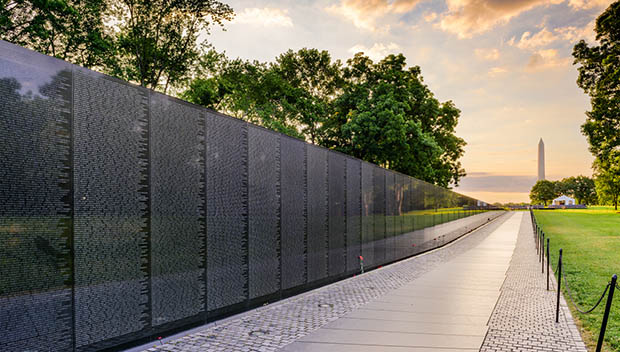
Memorial Day is a day when our country remembers those who died in active military service. Going to cemeteries, participating in parades, holding family gatherings or visiting memorials are ways in which Americans traditionally celebrate the holiday. To give your children a sense of this important holiday, we've rounded up 10 national park memorials to take your children to this Memorial Day.
Franklin Delano Roosevelt Memorial
Washington, D.C.
Franklin Delano Roosevelt was the longest-serving president in the United States, elected to serve four terms and navigated the rough waters of a country experiencing significant difficulties. After leading the country through the depression, his decision to enter World War II after the Japanese attack on Pearl Harbor had wide-sweeping consequences and ultimately led to the defeat of Nazi Germany.
General Grant Memorial
New York
General of the Union Army, Ulysses S. Grant had many victorious battles during the Civil War before forcing the surrender of the Confederacy. No one is known to have played a bigger role in the defeat of the Confederacy than Grant. Grant was elected as the 18th President of the United States. Though he was criticized because of the high number of Union soldier deaths during the Civil War, he was ultimately remembered as a savior of the Union.
Korean War Veterans Memorial
Washington, D.C.
The U.S. fought in the Korean War from 1950 to 1953 as a part of the Cold War, supporting South Korean in its battle against North Korea. Three hundred thousand Americans fought in the war and 36,000 of them died in battle. The Korean War was never won by either side but ended in a stalemate. Those that lost their lives in the war are remembered at the Korean War Veterans Memorial.
Lincoln Memorial
Washington, D.C.
One of the most beloved and well-known presidents, Abraham Lincoln is best remembered as the president that abolished slavery. Lincoln opposed slavery and his election to the presidency was a key impetus to the Civil War. Lincoln led the Union during the Civil War, and after the Union's victory, played a key role in uniting a divided country before he was assassinated in 1865, just a few months into his second term as president.
Pearl Harbor
Hawaii
The surprise attack on Pearl Harbor by the Japanese, which killed more 2,400 Americans and damaged 21 ships, forced the United States to enter World War II. Today, the monument to that moment preserves and interprets the stories of the Pacific War, including the shameful internment of Japanese Americans. The site also includes memorials to the USS Arizona, USS Oklahoma and USS Utah, which were completely lost during the attack.
Perry's Victory and International Peace Memorial
Ohio
This lesser-known monument is a memorial to Oliver Hazard Perry, a Commodore whose naval fleet defeated the British at the Battle of Lake Erie during the War of 1812. During that war, the United States fought Britain over its violations of U.S. maritime rights. Perry's success on Lake Erie secured U.S. control of the important body of water and eventually led to peace with Britain and Canada.
Vietnam Veterans Memorial
Washington, D.C.
The Vietnam War was a divisive war in which the communist army of North Vietnam fought South Vietnam and its primary ally, America. The war lasted from 1955 to 1975 and more than 3 million people, many of them Vietnamese civilians, were killed. Around 2.7 million Americans were deployed to fight alongside the South Vietnamese and 58,320 American service members were killed. Every single one of their names is inscribed in the black granite walls of the Vietnam Memorial.
World War I Memorial
Washington, D.C.
The U.S. entered "the war to end all wars" in 1917 until its end in 1918. This global war was one of the largest and deadliest wars in all of history. It began over disagreements on territories and boundaries in Europe. Though the United States initially stayed neutral, it eventually broke diplomatic relations with Germany and entered the war. More than 2 million Americans fought in France and more than 116,000 of them lost their lives.
World War II Memorial
Washington, D.C.
World War II began when Nazi Germany attacked Poland in 1939. The United States entered the war when it declared war on the Japanese after the Japanese bombed Pearl Harbor in 1941. In return Nazi Germany declared war on the United States. In the four years that America fought in the war, more than 16 million served and more than 400,000 of them were killed in action.
National D-Day Memorial
Virginia
Widely considered the most important victory for the allied forces during World War II, the D-Day Memorial remembers the day that American troops joined the allied forces to liberate France from the Nazis. More than 150,000 American and British troops landed on the beaches of Normandy to drive back the Germans. Their victory marked a turning point in the war.
READ THIS NEXT: 5 of the Best National Parks to Visit in the Summer









Discuss This Article